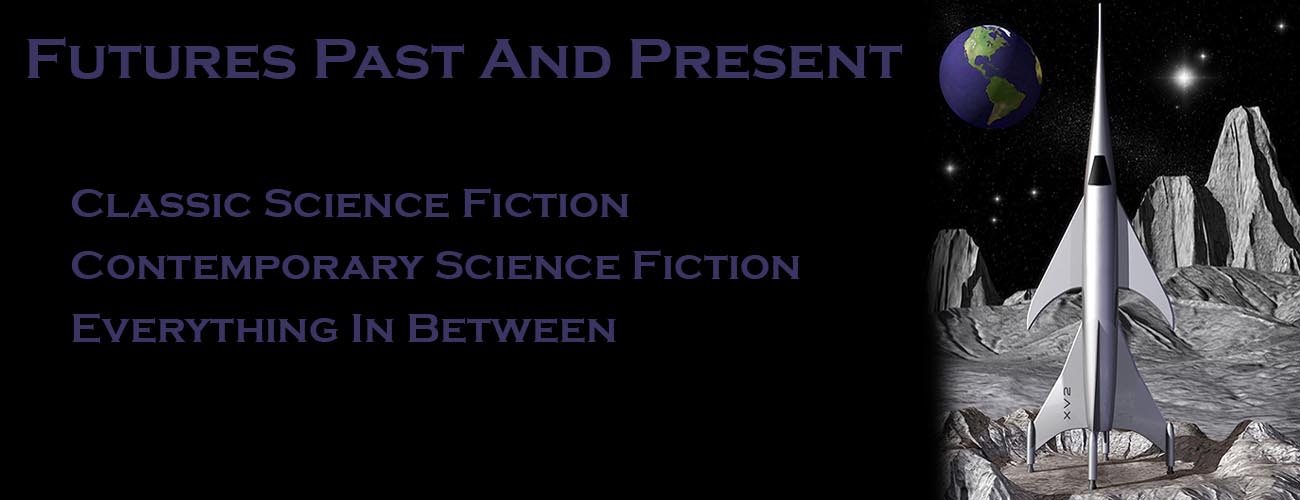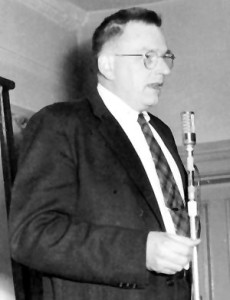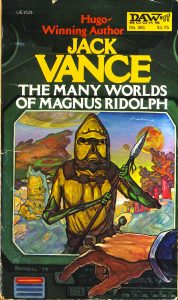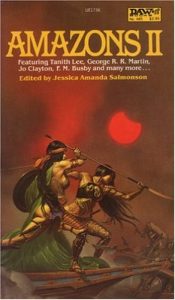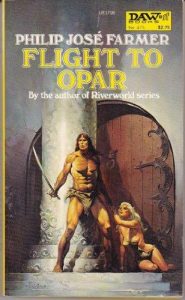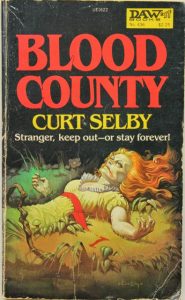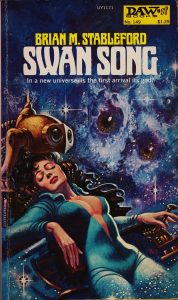Today, December 16, marks the birth of two of the best writers of science fiction, especially short science fiction. Randall Garrett (1927-1987) and Philip K. Dick (1928-1982). Of the two, Garrett is the least well-known and the one I prefer, although I like them both. Continue reading
Schmitz and Tubb
Today, October 15, marks the birthdays of two writers of adventure oriented science fiction.
 The first is James H. Schmitz (1911-1981). Most, but not all, of Schmitz’s work is set in the Hub. There are several recurring characters, including Telzey Amberdon, a telepathic young woman, and Trigger Argee, a special agent. Both of these ladies appeared in solo stories as well as shared adventures. These stories are a lot of fun. There are also a number of stand alone stories set in the Hub that don’t have recurring characters. Baen reprinted all (or almost all, there may have been one or two stories they couldn’t get the rights to) about 17 or 18 years ago. Outside the Hub, Schmitz’s best known works are The Witches of Karres and the Agent of Vega stories.
The first is James H. Schmitz (1911-1981). Most, but not all, of Schmitz’s work is set in the Hub. There are several recurring characters, including Telzey Amberdon, a telepathic young woman, and Trigger Argee, a special agent. Both of these ladies appeared in solo stories as well as shared adventures. These stories are a lot of fun. There are also a number of stand alone stories set in the Hub that don’t have recurring characters. Baen reprinted all (or almost all, there may have been one or two stories they couldn’t get the rights to) about 17 or 18 years ago. Outside the Hub, Schmitz’s best known works are The Witches of Karres and the Agent of Vega stories.
 One of Schmitz’s strengths are his ecosystems and his monsters. They are some of the most intriguing I’ve seen in science fiction. It’s been a number of years since I read Schmitz, but his work was always fun. I need to revisit them when I get a minute (which won’t be before the semester is over). The threats were serious, but his stories weren’t bleak or nihilistic like so much contemporary fiction is. One thing that stood out was many of Schmitz’s protagonists had families, and this dynamic added to the depth of the characters and world-building. His heroes and heroines weren’t all loners. They would be suitable to give to younger readers, as they don’t have any graphic sex or violence.
One of Schmitz’s strengths are his ecosystems and his monsters. They are some of the most intriguing I’ve seen in science fiction. It’s been a number of years since I read Schmitz, but his work was always fun. I need to revisit them when I get a minute (which won’t be before the semester is over). The threats were serious, but his stories weren’t bleak or nihilistic like so much contemporary fiction is. One thing that stood out was many of Schmitz’s protagonists had families, and this dynamic added to the depth of the characters and world-building. His heroes and heroines weren’t all loners. They would be suitable to give to younger readers, as they don’t have any graphic sex or violence.
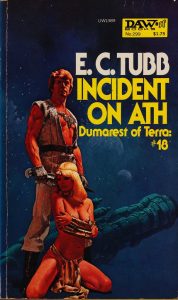 The other person born today that I want to recognize is E. C. Tubb (1919-2010). Although he wrote other characters and series, he’s best known for the Dumarest of Terra series, which ran to over thirty volumes. The premise is Earl Dumarest is seeking the planet of his birth, a mythical place called Earth. Each book involves him finding a bit more information. There’s also a secretive organization trying to stop him. I’ve only read the first one, and that was longer than I want to admit in public. I enjoyed it and have always intended to read more. I’m not sure how some of the later books hold up. I’ve heard various opinions on whether the series went too long. I’m hoping to reread the first and work some of the others into the queue over the next year.
The other person born today that I want to recognize is E. C. Tubb (1919-2010). Although he wrote other characters and series, he’s best known for the Dumarest of Terra series, which ran to over thirty volumes. The premise is Earl Dumarest is seeking the planet of his birth, a mythical place called Earth. Each book involves him finding a bit more information. There’s also a secretive organization trying to stop him. I’ve only read the first one, and that was longer than I want to admit in public. I enjoyed it and have always intended to read more. I’m not sure how some of the later books hold up. I’ve heard various opinions on whether the series went too long. I’m hoping to reread the first and work some of the others into the queue over the next year.
Saying “Farewell to the Master”
 “Farewell to the Master”
“Farewell to the Master”
Harry Bates
The Day the Earth Stood Still
Harry Bates was the first editor of Astounding Stories of Super-Science, known as Analog today. He was born on this date, October 9, in 1900.
Astounding Stories of Super-Science was the second science fiction pulp, intended as a competitor of Hugo Gernsback’s Amazing Stories. Bates is credited with infusing a sense of action and adventure into the field, in contrast to the stuffy, intellectual type of story favored by Gernsback. I’m going to have to read some of those stories and report back. Continue reading
Frank Herbert vs. Isaac Asimov
Today (October 8) marks the birth of Frank Herbert (1920-1986). Herbert wrote a number of novels and short stories, but he will always be known as the author of Dune. Dune was originally serialized in Analog (formerly Astounding) starting in December 1963. It was published in book form in 1965. The original publisher was Chilton. You know, the one that does the auto manuals.
Dune is set in a galactic empire, which is of course ruled by an Emperor. Herbert wrote a number of sequels, and his son Brian has coauthored additional sequels and prequels with Kevin J. Anderson.
Herbert wasn’t the first, nor was he the last, to use a galactic empire in a work of science fiction. One of the most prominent people to do the same was Isaac Asimov (who also wasn’t the first). Asimov started his Foundation series in the pages of Astounding roughly two decades earlier. It’s interesting to note that John W. Campbell was the editor for the original appearances of both series. I’m not going to go there in this post, because that sounds like a Ph.D. dissertation in Literature.
While comparisons have been made between the Dune series and Gibbon’s Decline and Fall of the Roman Empire, Asimov intentionally patterned the Foundation stories after Gibbon’s work. Several novels were set in the same universe before the time of the Foundation. Asimov would later go on to write additional novels in the last decade of his life and tie the series in with his robot stories, both the short stories concerning Susan Calvin and the detective novels starring Elijah Bailey and R. Daneel Olivaw. There were also a few sequels coauthored and/or authored by other writers.
Both Asimov and Herbert have been dead for a number of years. The influence of these two works has been tremendous. If you go into any bookstore today, most of the books by Asimov will be from the Foundation series, and most of the books by Herbert will be from the Dune series. Few, if any, of the titles you find by these authors will be outside these series.
Dune seems to be the more popular of the two at the moment, in part because new Dune titles are regularly being published, and also because there’s another film in the works. Foundation seems to be languishing a bit in comparison.
I read all the Foundation books Asimov wrote, although not all the galactic empire novels and none of the sequels. I’ve only read the original Dune. Dune Messiah and Children of Dune are in the TBR pile. I intend to reread Dune later this year; I first read it about 15 years ago. I read the original Foundation Trilogy…much longer ago than that, like in high school.
So I’m toying with the idea of reading the first three Dune books and the original Foundation Trilogy. This will be over the next year or three. I’ve got some other things to get through first. It will be interesting to see how they have stood the test of time from when I was younger.
As for what prompted this idea, well, that’s the topic of an upcoming post.
A Look at Wollheim (Don, That is)
Donald A. Wollheim was born on this date, October 1, in 1914. Although he wrote some fiction for the pulps, his greatest impact was as an editor, first at Avon, then Ace, and finally under his own label at DAW books.
Wollheim was responsible for bringing Edgar Rice Burroughs back into print, publishing Tolkien in paperback, and played a significant role in the emergence of mass market paperbacks and paperback anthologies.
He did like pulp, and DAW’s line until the time of his death reflected that. He published early work by such authors as C. J. Cherryh, Jo Clayton, and Brian Stableford. He also published some things that were rather controversial, such as John Norman’s Gor books.
Below is a sampling of some of the titles he published.
When Our Children’s Children Come to Visit
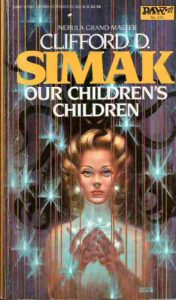 Our Children’s Children
Our Children’s Children
Clifford D. Simak
Ebook $9.99
It’s been a little while since I posted about Simak here, but that doesn’t mean I haven’t read any more of his work. I’ve just been slammed with work and haven’t had a chance to post. I’ve got at least one more Simak post coming up.
This short novel was published in 1974 after being serialized in Worlds of If. Like much of Simak’s work, it involves time travel.
The plot is fairly straightforward. Doorways open up all over the world, and people start pouring out of them. The spokesman for the newcomers tells the President that they are refugees from 500 years in the future. They are fleeing an alien invasion. Continue reading
Riding in The Ghost of a Model T with Clifford D. Simak
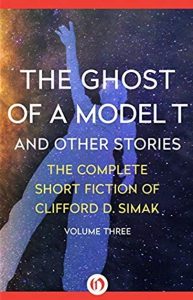 The Ghost of a Model T
The Ghost of a Model T
Clifford D. Simak
Open Road Media
print $21.99
ebook $7.99
Open Road Media publishes a lot of great science fiction and fantasy, and I mean A LOT. Much of it is from classic authors who have fallen out of print or writers who are still active and have an extensive backlist.
One of my favorite authors is Clifford D. Simak. Open Road has published a twelve volume set of his complete short fiction. They’ve also reprinted a number of his novels (although I’m still waiting for The Visitors).
Simak’s birthday was a week or so ago, and I did a post on it. I decided after rereading “All the Traps of Earth” that I would read some more of his work. In honor of Simak’s birthday, F&SF tweeted that his story “The Autumn Land”, which they had published back in October of 1971 had been shortlisted for the Nebula Award. So I decided to start with that on, which is one of the stories in The Ghost of a Model T. And I ended up reading the whole collection. Continue reading
Simak’s “All the Traps of Earth”
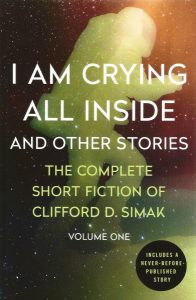 “All the Traps of Earth”
“All the Traps of Earth”
Clifford D. Simak
Originally published in The Magazine of Fantasy and Science Fiction, March 1960
Currently available in I am Crying All Inside: The Complete Short Fiction of Clifford D. Simak Volume One and Space Pioneers edited by Hank Davis and Christopher Ruocchio
Today, August 3, would have been Clifford D. Simak’s 115th birthday. Simak (1904-1988) wrote some of the best science fiction of the 20th Century. One of the themes he returned to, and it’s a theme in this story, is robots and their role in society.
When people talk about robots in science fiction, the name of Isaac Asimov naturally comes up. Simak might be mentioned if the people talking are well-read. Between the two, I prefer Simak’s robots to Asimov’s, although I very much enjoy Asimov’s robots. The difference, I think, is that Asimov’s robots tend to be cold and calculating, while Simak’s are more, well, human. Case in point, “All the Traps of Earth”. Continue reading
Remembering Charles Sheffield
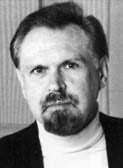 Charles Sheffield was born in England on this day, June 25, in 1935. He passed away in 2002. Sheffield was one of my favorite writers when I was in high school, college, and graduate school. A scientist, Sheffield wrote science fiction of the “hard science” variety, but with characters who were living, breathing human beings. They weren’t from Central Casting. He began his writing career after the death of his first wife in the late 70’s. By this time he was laready living in the United States.
Charles Sheffield was born in England on this day, June 25, in 1935. He passed away in 2002. Sheffield was one of my favorite writers when I was in high school, college, and graduate school. A scientist, Sheffield wrote science fiction of the “hard science” variety, but with characters who were living, breathing human beings. They weren’t from Central Casting. He began his writing career after the death of his first wife in the late 70’s. By this time he was laready living in the United States.
Sheffield was adept at both long and short forms. He wrote several series, as well as stand-alone novels, such as Godspeed, which has been described as the book we would have gotten had Robert Heinlein written Treasure Island. Most of his novels are still in print through Baen.
I wish someone would put together a retrospective of his work. Today is going to be hectic, but I’ll try to read a short piece by him and raise a glass to memory this evening.
Remembering Murray Leinster
 Will F. Jenkins, better known by his pseudonym Murray Leintster, was born this day (June 16) in 1896. He passed away on June 8, 1975, just eight days short of his 79th birthday.
Will F. Jenkins, better known by his pseudonym Murray Leintster, was born this day (June 16) in 1896. He passed away on June 8, 1975, just eight days short of his 79th birthday.
Leinster wrote for a variety of pulp magazines, but his greatest output was in the field of science fiction, beginning with “Atmosphere” in Argosy in 1918. While he wrote novels, his best work was at shorter lengths. Some of these stories include “Sidewise in Time”, “First Contact”, “A Logic Named Joe”, and “Exploration Team”. These stories have become classics in the field, and “Exploration Team” won one of the first Hugo Awards.
I’ve always enjoyed Leinster’s work. As with any prolific author, not all the stories are of equal quality, but when Leinster was good, he was very good.
Later in the summer, when things settle down, i.e., when the second summer session starts and I’m teaching, one of the things I want to do is restart the Pre-Campbell Science Fiction Challenge. Leinster will be one of the authors I’ll be reading.
